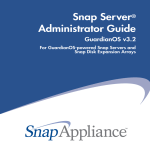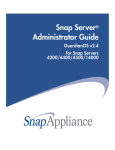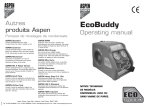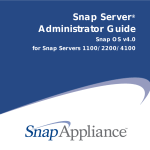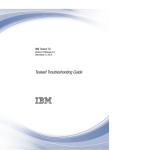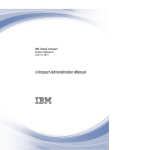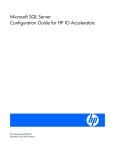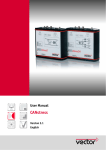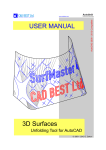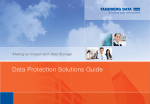Download Adaptec Snap Server 18000
Transcript
SQL Server 2000 iSCSI Snap Server™ 18000 Characterization Prepared for SNAP Appliance by Interlink Group, INC February 16, 2005 Interlink Group, LLC 98 Inverness Drive East, Suite 150 Englewood, CO 80112 Phone: 303-542-7100 Toll Free: 888-533-1307 http://www.interlinkgroup.com SQL SERVER 2000 ISCSI SNAP SERVER™ 18000 CHARACTERIZATION Contents 1. INTRODUCTION .......................................................................................................................................................3 1.1 Document Overview ............................................................................................................................................3 1.2 Audience ................................................................................................................................................................3 2. SOLUTION OVERVIEW ............................................................................................................................................3 2.1 Statement of the Problem ....................................................................................................................................3 2.2 Solution Description ............................................................................................................................................3 2.3 Approach ...............................................................................................................................................................4 3. TESTING METHODOLOGY.....................................................................................................................................4 3.1 Tool Selection ........................................................................................................................................................4 3.2 Lab Configuration ................................................................................................................................................5 3.3 Read and Write Test Approach ............................................................................................................................5 3.3.1 Test Scripts .......................................................................................................................................................6 3.3.2 Test Procedure .................................................................................................................................................6 3.4 Resiliency Test Approach......................................................................................................................................7 3.4.1 Test Procedure .................................................................................................................................................7 4. TEST CASES AND RESULTS .....................................................................................................................................7 4.1 Read & Write Tests................................................................................................................................................8 4.1.1 Baseline Test – Database & Logs on Internal Direct Attached Drive.........................................................8 4.1.2 Test 1 – Logs & Database on Mirrored iSCSI Disks ....................................................................................8 4.1.3 Test 2 – Database on iSCSI Disks & Logs on Internal Direct Attached Drive ..........................................9 4.1.4 Test Results Comparison ................................................................................................................................9 4.2 Resiliency Tests .....................................................................................................................................................12 4.2.1 General Comments.......................................................................................................................................12 5. RECOMMENDED ARCHITECTURE....................................................................................................................12 5.1 Conceptual Design...............................................................................................................................................12 5.2 System Requirements...........................................................................................................................................13 5.3 Configuration Details ..........................................................................................................................................13 5.3.1 Dedicate Storage Backbone..........................................................................................................................13 5.3.2 Install iSCSI TOE Card.................................................................................................................................13 5.3. Database Architecture .....................................................................................................................................14 5.3.4 Optimize Cache.............................................................................................................................................14 5.3.5 Installation and Volume Creation Procedures ...........................................................................................14 5.3.6 iSCSI Initiator Startup Procedures ..............................................................................................................14 5.4 iSCSI Protocol .....................................................................................................................................................14 5.5 Microsoft Windows iSCSI Initiator Service .....................................................................................................15 6. CONCLUSION...........................................................................................................................................................15 2 SQL SERVER 2000 ISCSI SNAP SERVER™ 18000 CHARACTERIZATION Introduction Adaptec is the worldwide volume leader in network attached storage (NAS) products, offering its customers the successful Snap Server family of Network Attached Storage servers. These NAS solutions combine the most reliable and cost-effective technologies with industry-leading ease of integration. Adaptec is actively developing new features and capabilities that extend the traditional NAS appliances into an iSCSI target that supports both block and file needs. By combining these new iSCSI capabilities with industry-leading ease of integration, Adaptec strongly believes there are significant opportunities to target applications within the enterprise that require block-level services. In order to target and sell to these enterprise customers, Adaptec has positioned its storage appliance in terms of an overall solution. The introduction of low-cost, high-performance storage devices provides new opportunities for enterprise IT to use storage in innovative ways that were previously cost-prohibitive or not technically feasible. One such opportunity is to leverage iSCSI devices for use in database applications. Unlike previous NAS devices that were file based, iSCSI brings blocklevel access and high performance to a lower-cost storage medium. This presents a compelling reason for IT to evaluate the potential for iSCSI as primary storage for database applications. 1.1 Document Overview This document is intended to provide Adaptec with hard data from lab testing as to how the Adaptec iSCSI device compares against direct attached local SCSI disk storage in Microsoft® SQL Server™ 2000 applications. Interlink has provided this information within this document in the following format: • Solution Overview – A general understanding of the benefits and issues associated with using NAS devices as Microsoft® SQL Server™ 2000 primary storage. • Testing Methodology – How Interlink approached a generalized performance characterization of Microsoft® SQL Server™ 2000. • Test Results – A review of all test results with interpretation of findings. • Recommended Architecture - Defines a high-level architecture based on testing results along with recommendations for extending this architecture in an Exchange production environment. • Conclusion – A summary of findings and recommendations. 1.2 Audience This document assumes the reader has a moderate understanding of networking and server environment technology terms and acronyms. The intended audience is Adaptec customers, IT managerial and technical personnel. 2. Solution Overview This section briefly describes the technical problem that the solution addresses, as well as a general overview of how Interlink approached the generalized performance testing of the Adaptec Snap Server iSCSI device in a Microsoft® SQL Server™ 2000 environment. 2.1 Statement of the Problem If one were to ask the question, “is this storage device suitable for use as Microsoft® SQL Server™ 2000 primary storage?” the answer would have to be “it depends”. There are infinite ways that Microsoft® SQL Server™ 2000 can be used to address common business problems today. Each usage case will have its own associated performance requirements that might embrace or preclude the use of one storage method over another. Enterprises considering the use of new, lower-cost network attached storage devices with the iSCSI protocol with Microsoft® SQL Server™ 2000 need to be assured of the performance characteristics in this database environment. When evaluating potential storage solutions for a Microsoft® SQL Server™ 2000 environment, the following attributes should be taken into consideration: • Performance – Does the solution meet the performance requirements for the particular application of Microsoft® SQL Server™ 2000? • Availability – Does the solution have the necessary architecture to ensure adequate failure protection such as built in redundancy of components, data striping, etc.? • Recoverability – In the event of a failure or corruption, can data be quickly recovered? • Flexibility – Does the solution offer flexibility in terms of adding capacity, modifying storage allocation, accommodating multiple different RAID sets, etc.? • Manageability – Can the device be easily managed and administered without complex knowledge requirements? 2.2 Solution Description The Snap Server iSCSI solution is an attractive alternative to other storage scenarios for the following reasons: • Adaptability – The use of network attached storage can help IT reduce isolated server-centric disk storage that results in “islands of information”. Administrators can quickly modify space allocation based on changing business requirements without having to perform complex and risky data backup and restoration. Storage administrators can allocate a single device for multiple usage scenarios (e.g. 3 SQL SERVER 2000 ISCSI SNAP SERVER™ 18000 CHARACTERIZATION file-level access for file and print, or block-level access for database and messaging applications). • High Capacity vs. Cost – Adaptec offers terabytes of capacity at reasonable price points that create opportunities for storage optimization and centralization in organizations that were previously unable to afford such solutions. • Rapid Recovery – Adaptec has bundled industry-known software products with its offerings for rapid data recovery. Its support for industry standards in file access (NFS and CFS) and emerging block-level access (iSCSI) also eliminates having to resort to expensive proprietary recovery mechanism and allows the use of third-party solutions. • Existing Infrastructure – iSCSI architecture leverages existing network infrastructure technology that is well understood in most organizations and does not require investment in alternative storage infrastructures, such as Fibre Channel. 2.3 Approach As stated above, the difficulty in characterizing performance for Microsoft® SQL Server™ 2000 is the myriad of ways in which it can be deployed. It would be a daunting task to state definitively that a storage device would perform in a certain way in a unique scenario. However, it is reasonable to perform specific and defined testing scenarios that would give a potential user of an iSCSI storage device a general idea of how that device would perform over direct attached storage (DAS). At a very generic level, most applications of Microsoft® SQL Server™ 2000 can be placed into three very broad categories: • Simple Data Model: In this category, Microsoft® SQL Server™ 2000 is used as a simple repository for data. High performance is not usually essential, as the transaction count is relatively low. Reads and writes to databases tend to be more sequential in nature. Examples of applications that would use SQL in this manner might be SharePoint Portal Server or Microsoft Operations Manager. • Transactional: This category is more performance-dependent in that a transactional application makes frequent reads and writes. Data reads and writes are highly random rather than sequential. Usually transactional applications require high availability, robust I/O performance, and rapid recoverability. On line business and e-Business applications would utilize this model. • OLAP: Microsoft® SQL Server™ 2000 is increasingly being used for Online Analytical Processing, which primarily involves aggregating large amounts of diverse data. OLAP can involve millions of data items with complex relationships. NAS devices lend themselves to this model in that a point in time “snapshot” of a production database can be made and analysis run against that “near-time” data without impacting performance on the production systems. Interlink’s choice of testing tools reflect a model that encompasses the first two models, as they are probably more representative to typical use scenarios where an iSCSI Snap Appliance device would be deployed. Interlink test scenarios included database sizes of 1, 10, and 100 gigabytes in various configurations. Resiliency of configurations was also tested to simulate component failures and how the Snap Server would handle the failures. It is important to note that Interlink’s testing of the Snap Server exercised a very limited scenario so that performance characteristics could be generally identified in comparison to local SCSI disk. Due to the large numbers of variables that could impact performance, Interlink and Adaptec make no guarantee or claim that similar performance would be achieved in a production environment. As they say in the car commercials, “your actual mileage may vary”. 3. Testing Methodology This section describes the lab configuration, read and write testing approach, and the resiliency testing approach Interlink used to characterize performance of the Snap Server™ 18000 with Microsoft SQL Server 2000. 3.1 Tool Selection For benchmarking Microsoft SQL performance, Interlink felt that it was important to use tools that actually stressed and tested a live Microsoft® SQL Server™ 2000 environment. Microsoft has developed some testing tools available that provide “synthetic testing” that simulates Microsoft® SQL Server™ 2000 I/O without actually using the Microsoft® SQL Server™ 2000 application. Similarly, benchmarks can be found using the IOMETER tool that was originally developed by Intel. Although this tool provides good generic I/O comparative measurements, it does not exercise Microsoft® SQL Server™ 2000 to obtain its data, and that data must be extrapolated to predict Microsoft® SQL Server™ 2000 performance characteristics. Interlink felt that using a tool that did not perform actual Microsoft® SQL Server™ 2000 operations invalidated the testing. After evaluating Microsoft-provided tools like SQLIO and SQLIOStress that performed synthetic testing, Interlink decided to use testing tools that performed actual tests on real Microsoft® SQL Server™ 2000 databases. These tools included: • DBGen – To better understand read performance, Interlink focused on disk throughput. Interlink leveraged the Microsoft® SQL Server™ 2000 Resource Kit “DBGen” tool to generate random data for a 1GB database (3.5 million row table), a 10GB database (35 million row table), and a 100GB database (350 million row table). • SQL Scripts – With the data randomly created for the three databases, the first test used a basic SQL select statement to test disk throughput as read operations. Since the databases 4 SQL SERVER 2000 ISCSI SNAP SERVER™ 18000 CHARACTERIZATION did not have any indexes created on the columns, all read operations were complete table scans and provided a good measure of disk throughput. To test write performance under heavy conditions and understand drive performance and throughput to the Snap Server™ 18000, Interlink used DTS to copy in bulk a 3.5 million row, 35 million row, and 350 million row tables for each test configuration. • Perfmon Counters – Interlink used the built-in “Performance Monitor” utility in Windows Server 2003 to monitor, log, and average various system performance counters including CPU parameters, physical disk performance, network performance, and Microsoft® SQL Server™ 2000 performance. ed this configuration and built two new RAID sets: • One RAID 1 set was created on the first two disks for the transaction logs for the Test 1 configuration. • One RAID 5 set was created using the remaining six 250GB disks to hold the databases for Tests 1 and 2 configurations. For all tests, Microsoft best practices were followed by separating transaction logs (sequential data access) and database files (random data access) onto different physical drives. Table 1 lists the logical drive letter allocation, the RAID level, the number of drives, and the purpose of each drive. Figure 1 illustrates the Interlink test lab hardware configuration. Section 3.3 further describes how Interlink used these tools to characterize the Snap Server™ 18000 with Microsoft® SQL Server™ 2000. 3.2 Lab Configuration Interlink built the test server (ILGTEST3) with Windows Server 2003 Enterprise Edition in a workgroup configuration. Microsoft® SQL Server™ 2000 Enterprise Edition was installed and configured using defaults for the Microsoft® SQL Server™ 2000 application file locations. For the baseline test, Interlink configured two internal drives in RAID 1 for the OS and Microsoft® SQL Server™ 2000 installation. The other two internal drives were configured in RAID 1 for the transaction logs of the baseline and Test 2 configuration tests. Interlink configured the remaining eight external expansion chassis drives in RAID 5 for the database files for the baseline configuration tests. Then, Interlink installed the Snap Server™ 18000 (SNAP900148) in the test lab and configured it for the same workgroup as test server. The Snap Server™ 18000 was shipped with eight 250GB disks in a default RAID 5 configuration. Interlink delet- Figure 1 –Test Lab Environment Table 2 lists the servers and devices used within the test lab environment, platform/OS/software, TCP/IP address, and a description of the function performed. 3.3 Read and Write Test Approach Using the test scripts in section 3.3.1, Interlink benchmarked (e.g. baseline configuration) the read and write performance characteristics of a 1GB, 10GB, and 100GB database placed on Table 1 – Logical Drive Letter Allocation Logical Drive Letter Physical Location RAID Level Purpose Number of Drives Test Scenario L Internal SCSI Raid 1 Transaction Logs 2 Baseline, Test 2 G External SCSI Chassis Raid 5 Database 8 Baseline H Snap Server iSCSI Attached Raid 1 Transaction Logs 2 Test 1 I Snap Server iSCSI Attached Raid 5 Database 6 Tests 1, Test 2 Table 2 – Lab Servers and Devices Server Name Platform/OS/Software TCP/IP Address Description/Function ILGTESTS3 • Compaq DL380 • Windows Server 2003 Enterprise Edition • Microsoft® SQL Server™ 2000 Enterprise Edition, SP3a 10.202.2.5 10.200.2.5 • Workgroup Server • Microsoft® SQL Server™ 2000 Database Server SNAP900148 • Snap Server™ 18000 device • GuardianOS™ v3.2.019 10.200.2.4 • NAS device • SMC gigabit, 5-port switch 192.168.1.2 (management port) • 10/100/1000 Ethernet Network Switch Note: The Snap Server™ 18000 device only supports RAID levels 0, 1, and 5. 5 SQL SERVER 2000 ISCSI SNAP SERVER™ 18000 CHARACTERIZATION the “L” drive (transaction log) and “G” drive (database) running on locally attached SCSI storage and compare those numbers to two separate test configurations leveraging the Snap Server™ 18000. The two specific Snap Server™ 18000 configurations included: 1. Test 1 Configuration - Logs & Database on iSCSI Disks: Using the test scripts in section 3.2, Interlink tested read and write performance characteristics of a 1GB, 10GB, and 100GB database placed on the “H” drive (transaction log) and “I” drive (database). 2. Test 2 Configuration - Database on iSCSI Disks & Logs on Internal Direct Attached Drive: Using the test scripts in section 3.2, Interlink tested read and write performance characteristics of a 1GB, 10GB, and 100GB database placed on the “L” drive (transaction log) and “I” drive (database). Interlink then used the Database Generator sample (DBGen) available in the \ToolsAndSamples\DBGen folder on the Microsoft® SQL Server™ 2000 Resource Kit CD to generate 1GB, 10GB, and 100GB databases for read and write tests. The Database Generator is a sample ODBC-based tool designed to populate tables in a database with a set of sample data. DBGen allows you to choose the type of data distribution you prefer from a list of available distributions. The source code for the Database Generator sample is included as a compressed file named Dbgen.zip. Database Generator requires the following: • Microsoft® SQL Server™ 2000. • A file compression program that supports ZIP compressed files, in order to access the sample source code. • Microsoft Visual Basic® 6.0, to access the source code for Dbgen.exe. • Microsoft Visual C++® 6.0, to access the source code for Dbgencom.exe. • Microsoft® SQL Server™ 2000 security is required to log on when you use the tool; Microsoft Windows NT® Integrated security is not supported. 3.3.1 Test Scripts Interlink created and ran the exact same read and write test scripts against the nine databases to compare the baseline configuration with each of the two test configurations leveraging the Snap Server™ 18000. The two specific test scripts included: 1. Test Script 1 – Read (Select) Performance To better understand read performance, Interlink focused on disk throughput. Interlink developed a 1GB database (3.5 million row table), a 10GB database (35 million row table), and a 100GB database (350 million row table). Interlink leveraged the Microsoft® SQL Server™ 2000 Resource Kit “DBGen” tool to generate random data for the three databases. Interlink created a table using a script provided with DBGen: Create table examples ( c_uniqueint, c_zdist int, c_edist char(255), c_udist varchar(80), c_ndist float, c_domain varchar(40) ) Go This script created a table that is six columns wide with varying data types. Next, Interlink launched the DBGen application and specified the server name, the database name, the login name, and password. DBGen requires that the number of rows to create be specified prior to randomly generating data in each of the six columns. For example, Interlink specified that DBGen create 3.5 million rows for the 1GB database. With the data randomly created for the three databases, the first test used a basic SQL select statement to test disk throughput as read operations for the test databases. Since the databases did not have any indexes created on the columns, all read operations were complete table scans and provided a good measure of disk throughput. Interlink also stopped and started Microsoft® SQL Server™ 2000 before each select statement to ensure that SQL caching did not influence the performance characteristics. Interlink used the following query to test and measure read performance: Select c_unique, c_udist from examples This query returned all rows for the two columns specified. Interlink chose columns of varying data types to get a good mixture of data select types. 2. Test Script 2 – Write (Insert) Performance Using DTS, Interlink copied in bulk a 3.5 million row table, 35 million row table, and 350 million row table to each test scenario, to test drive throughput to the Snap Server™ 18000. Interlink decided to use this method to test write performance under heavy conditions to understand drive performance. 3.3.2 Test Procedure Interlink ran each test in a very precise and consistent manner to ensure accuracy and comparable results across each test size and test configuration. Table 3 lists the steps performed for each test configuration. 6 SQL SERVER 2000 ISCSI SNAP SERVER™ 18000 CHARACTERIZATION 3.4 Resiliency Test Approach In order to attain consistent results for comparison, Interlink introduced a uniform set of faults to the baseline configuration and the Test 1 configuration using the Snap Server™ 18000. Prior to executing each fault test on each of the test configurations, Interlink started a 1GB DTS write operation and then a customized performance monitor to gather metrics. each factor, and the order in which they were introduced. Interlink waited for a period of time after the completion of each factor tested in order for the system to normalize. 4. Test Cases and Results This section describes the read and write test cases and testing results Interlink used to characterize performance of the Snap Server™ 18000 with Microsoft® SQL Server™ 2000. 3.4.1 Test Procedure Table 4 illustrates the resiliency factors tested, a description of Table 3 – Test Steps Step Description Procedure Comments Open performance monitor and configure counters. Under Performance Logs and Alerts, create a new Log Settings under Counter Logs. Save these log settings to be used for all tests. Once created, the same log settings will be used for every test. 1 2 Execute Test Script 2 (Write) to appropriate database. Using Microsoft® SQL Server™ 2000 Enterprise Manager, use DTS to import data to appropriate database. Saved table in the destination database will be called examples. Start Performance Counter. Right mouse click on the saved log settings and choose start. Interlink started the perfmon after the test script was executed to ensure no 0 values would occur in the test data. Right mouse click on saved log settings and choose stop. Using Windows Explorer, rename the file to DTSBaseline’DBSize’.blg to ensure the proper perfmon file corresponds to the appropriate test. Interlink stopped the perfmon log immediately after the test script ended to ensure no 0 values would occur in the test data. 5 When test script ends, stop performance monitor. Rename Performance monitor log file to DTSBaseline’DBSize’.blg. 6 Stop and Start Microsoft® SQL Server™ 2000. Using Services, stop and start the MSSQLServer service. Interlink performed this step to ensure that SQL caching did not influence test results. Execute Test Script 1 (Read) to appropriate database. Using Microsoft® SQL Server™ 2000 Query Analyzer, This is a select statement on the targeted table (e.g. 1GB, 10GB run ‘Select c_unique, c_udist from examples’. or 100GB) containing test data. The result is that all rows in the table are selected and the columns returned are c_unique and c_udist. Right mouse click on the saved log settings and Interlink started the perfmon after the test script was executed choose Start to ensure no 0 values would occur in the test data. 3 4 7 8 Start Performance Counter. 9 When test script ends, stop performance monitor. Right mouse click on saved log settings and choose stop. Interlink stopped the perfmon log immediately after the test script ended to ensure no 0 values would occur in the test data. 10 Rename Performance monitor log file to ReadBaseline’DBSize’.blg. 11 Stop and Start Microsoft® SQL Server™ 2000. Using Windows Explorer, rename the file to ReaadBaseline’DBSize’.blg to ensure the proper perfmon file corresponds to the appropriate test. Using Services, stop and start the SQLServer service. Interlink performed this step to ensure that SQL caching did not influence test results. Table 4 – Resiliency Factors Tested Test 1 Resiliency Factors Tested (or introduced faults) Description of Factors Tested Remove one hard drive from the database drive set, and re-introduce failed drive during SQL operation Remove one hard drive from the transaction log drive set, and introduce failed drive during SQL operation This will introduce a degraded disk performance condition. After a little time, introduce the failed drive back into the array to let the system rebuild the array during the SQL operation. This will introduce a degraded disk performance condition. After a little time, introduce the failed drive back into the array to let the system rebuild the array during the SQL operation. 3 Unplug one network cable from the Snap Server™ 18000 system, while the database testing is in process This will reduce the network bandwidth available for database operations and is used to simulate a failed network interface card (NIC). When complete, repair the network cable by plugging the cable back in to the Snap Server™ 18000 system head unit. This will restore the network subsystems to pre-test condition. 4 Unplug one network cable from the Snap Server™ 18000 system, while the disk set is in the rebuild process This will reduce the network bandwidth available for disk rebuild operations and is used to simulate a failed network interface card (NIC) in iSCSI scenarios. When complete, repair the network cable by plugging the cable back in to the Snap Server™ 18000 system head unit. This will restore the disk subsystems to pre-test condition. 5 Power off Snap Server™ 18000 and baseline external SCSI This will fracture the communications between the Snap Server™ 18000 system, and the enclosure, unexpectedly during database testing external SCSI storage, with the host system and affecting disk operations. 2 7 SQL SERVER 2000 ISCSI SNAP SERVER™ 18000 CHARACTERIZATION 4.1 Read & Write Tests Interlink used the built in “Performance Monitor” utility in Windows Server 2003 to monitor, log and average various system performance counters including CPU parameters, physical disk performance, and network performance. 4.1.1 Baseline Test – Database & Logs on Internal Direct Attached Drive Prior to Adaptec scenario testing, a baseline configuration matching a typical customer scenario was tested in order to provide a known condition against which to measure. The configuration used to represent a typical customer’s Microsoft® SQL Server™ 2000 is as follows: • Compaq Proliant DL 380, dual processor Pentium III, Server class • 1GB RAM • Integrated non-accelerated RAID card for internet disk, hardware-accelerated RAID card with battery backed cache for external expansion chassis • Dedicated OS/Application drive • Dedicated log drive in a RAID 1 configuration • Dedicated database drive in a RAID 5 configuration The setup for baseline testing consisted of the creation of 2 RAID volumes on the ILGTESTS3 server and installing Microsoft® SQL Server™ 2000 along with the latest service pack (SP3a). The default C: drive was used only to host the operating system and to run the application executables. The first volume was created using two internal disks configured in a Raid 1 (mirrored) set for the transaction logs. The second volume was created using eight drives configured in a Raid 5 (stripped with parity) set for the database files. The drives were logically assigned the L drive for the transaction logs, and the G drive for the database files. Table 5 below lists the baseline performance test results. A second disk set comprised of six hard drives in a RAID 5 set was created to hold the database. Both disk sets had a single volume created on them. An iSCSI volume was associated with each respective volume. The test Microsoft® SQL Server™ 2000, ILGTESTS3, was configured to attach to the two iSCSI volumes using the Microsoft iSCSI initiator component so that they are presented as local disk. Once the volumes are configured on the ILGTESTS3 server, the transaction log drive was assigned the “H” drive letter, and the data drive was assigned the “I” drive letter. Interlink then created the three databases (1GB, 10GB, and 100GB) using these drive letters for this test. The Test 1 configuration attempted to simulate the performance of the Snap Server™ 18000 device when it was configured similar to the local server. The transaction log files and database files are all stored on the Snap Server™ 18000’s storage system, in comparison to the transaction log files and databases being all “local” to the server on SCSI. The disks within the Snap Server™ 18000 are running at 7200 RPM, they are not as fast as the 10,000 RPM Wide-Ultra SCSI disks. Table 6 (below) lists the Test 1 configuration performance test results. Using our top 3 performance indicators, Figure 2 illustrates the percent difference for all database sizes in the Test 1 configuration compared to the baseline configuration. 4.1.2 Test 1 – Logs & Database on iSCSI Disks To create this scenario, two volumes were created on the Snap Server™ 18000. One disk set was created with two drives configured in a RAID 1 mirrored set to hold the transaction logs. Figure 2 – Test 1 Configuration Performance Test Results Table 5 – Baseline Performance Test Results LG Write Bytes/Sec DB Write Bytes/Sec DB Read Bytes/Sec Avg. Disk Read Queue Length Avg. Disk Write Queue Length % Processor Time Read % Processor Time Write 1GB Base 487446.422 8179131.174 22248813.04 0.61 28.58 54.39 86.22 10GB Base 290776.324 7526451.27 22920794.11 0.61 1.53 60.49 89.38 100GB Base 320404.18 7991059.35 15543701.09 1.52 37.83 60.43 84.12 Test Performed Table 6 – Test 1 Performance Test Results LG Write Bytes/Sec DB Write Bytes/Sec DB Read Bytes/Sec Avg. Disk Read Queue Length Avg. Disk Write Queue Length % Processor Time Read % Processor Time Write 1GB Test 1 418537.963 7723526.997 15717719.11 0.31 8.64 61.56 88.67 10GB Test 1 273422.348 6635551.485 17650823.83 0.51 7.66 61.59 86.73 100GB Test 1 279209.936 7087308.909 11703422.65 0.28 16.35 59.28 84.98 Test Performed 8 SQL SERVER 2000 ISCSI SNAP SERVER™ 18000 CHARACTERIZATION Figure 3 – Test 2 Configuration Performance Test Results 4.1.3 Test 2 – Database on iSCSI Disks & Logs on Internal Direct Attached Drive To create this scenario, Interlink placed the transaction logs for these databases on the locally attached “L” drive, and placed the database files on the “I” drive. This design splits the database between locally attached storage for the transaction logs and the Snap Server for the database files. Interlink wanted to test this scenario to see if this configuration would offer any performance benefits by having transaction logs on local disk. The Test 2 configuration attempted to present a more normalized, yet more optimized, configuration by placing the transaction logs on the fastest drives within the server and the database on the most expandable system (Snap Server™ 18000). Interlink initially assumed that this configuration would perform slightly better than Test 1, but still not equal to the baseline because of the placement of the transaction logs on local storage. The test data does support the theory showing faster log write bytes/sec, whereas the database read bytes/sec were basically equal. Table 7 (Below) lists the Test 2 configuration performance test results. Again using our top three performance indicators, Figure 3 illustrates the percent difference for all database sizes in the Test 2 configuration compared to the baseline configuration. In a Microsoft® SQL Server™ 2000 database, a transaction must first be successfully written to the log before it will be committed to the database. It does this for performance reasons. Writes to a transaction log are sequential, and thus, very fast. If writes were to pass straight to the database first, they would be very slow, as they would be contending with random reads already occurring on the database. In this particular scenario, all writes to the transaction log must first pass through the hardware RAID card to be written to the transaction log, then down through the stack to the iSCSI redirector, and finally to the RAID card within the Snap Server™ 18000 to be written finally to the database. 4.1.4 Test Results Comparison The six charts shown in Figure 4 on the next two pages illustrates the 1GB, 10GB, and 100GB performance characteristics of the two Snap Server™ 18000 test configurations to the baseline configuration. In order to understand disk throughput, Interlink captured database write bytes per second, database read bytes per second, and log write bytes per second. Interlink discovered two similarities from the performance test results. 1. The baseline configuration tests were faster than the two Snap Server™ 18000 test configurations, and 2. The two Snap Server™ 18000 test configurations performance database read results were basically equal with improvements in the Test 2 scenario for database writes Table 7 – Test 2 Performance Test Results LG Write Bytes/Sec DB Write Bytes/Sec DB Read Bytes/Sec Avg. Disk Read Queue Length Avg. Disk Write Queue Length % Processor Time Read % Processor Time Write 1GB Test 2 486914.464 7752401.874 18867012.02 0.50 33.44 61.06 88.97 10GB Test 2 313329.314 7588861.439 17787942.92 0.48 13.19 62.34 87.36 100GB Test 2 293437.398 7385352.749 12230381.73 0.27 9.44 57.79 86.21 Test Performed 9 SQL SERVER 2000 ISCSI SNAP SERVER™ 18000 CHARACTERIZATION Figure 4 – 1GB, 10GB, and 100GB Performance Test Results SQL SERVER 2000 ISCSI SNAP SERVER™ 18000 CHARACTERIZATION 11 SQL SERVER 2000 ISCSI SNAP SERVER™ 18000 CHARACTERIZATION Interlink did expect the baseline configuration to outperform the two Snap Server™ 18000 test configurations since the SCSI interface and interconnect are faster than 1000Base-T Ethernet, and the SCSI Ultra-Wide drives are faster than the ATA drives in the Snap Server. However, some Test 2 performance metrics were very close and some slightly better than the baseline tests. Interlink also expected that Test 2 would outperform Test 1. The performance data shows that in fact Test 2 did outperform Test 1 in regards to log write bytes per second, whereas the database read operations were basically equal. Because of the test results, the optimum choice would be keeping transaction logs on the fastest disks available, while moving the larger and growing database data files to the more flexible and more inexpensive iSCSI storage. Interlink did expect the network connectivity between the server and the Snap Server™ 18000 to be a bottleneck of this system. One performance counter, Network Output Queue Length, was observed on the NIC. This counter measured data being queued on the NIC that needed to be sent over the network and was present during the database write operations. This does indicate that network bandwidth and latencies were indeed a bottleneck of this design. The speed difference is definitely noticeable, but when you factor the price difference between the two storage options, as well as the ability to grow the Snap Server™ 18000 very easily among multiple servers, it is easy to justify the investment in the Snap Server™ 18000. 4.2 Resiliency Tests The results of the resiliency testing are summarized in this section. The results are compared to the baseline and expressed as a Pass or Fail, and the description. 4.2.1 General Comments Adaptec has taken many great steps to increase the reliability and usability of their Enterprise products. The Snap Server™ 18000 boasts dual processors and dual power supplies, both of which are improvements over its predecessor. The Snap Server™ 18000 has a very functional internal layout with four hotswappable CPU fans and five hot-swappable chassis fans. One great feature that is new to Adaptec products is the addition of a LCD screen on the Snap Server™ 18000. The screen displays the boot up procedures during reboots and displays the server name and IP address when the server is operational. 5. Recommended Architecture This section describes the conceptual design, system requirements, and configuration details Interlink recommends when integrating the Snap Server™ 18000 with Microsoft® SQL Server™ 2000 to extend the life of an existing database server. 5.1 Conceptual Design The flexible, inexpensive, and simplistic nature of the Snap Server™ 18000 allows for a quick and easy deployment of a Network Attached Storage (NAS) combined with the Internet SCSI (iSCSI) protocol to allow volumes from the NAS device to be mounted to the Microsoft® SQL Server™ 2000 server(s) as a local volume. Once mounted as a local volume, it can be Table 8 – Resiliency Test Results Test Baseline Snap Appliance, Test 1 Configuration 1 Pass Pass For Test 1 configuration, when a drive was removed, the Snap Server™ 18000 operated as expected. The array was degraded and the SQL operation continued. When a drive was re-inserted, and a repair process was initiated manually to synchronize the array back to a healthy state, the SQL operation continued and the repair process seemed to wait until drive I/O operations were limited before beginning the repair process. 2 Pass Pass For Test 1 configuration, when a drive was removed, the Snap Server™ 18000 operated as expected. The array was degraded and the SQL operation continued. When a drive was re-inserted, and a repair process was initiated manually to synchronize the array back to a healthy state, the SQL operation continued and the repair process seemed to wait until drive I/O operations were limited before beginning the repair process. 3 N/A Pass For Test 1 configuration, the SQL Operation continued during the degraded network connection state. 4 N/A Pass For Test 1 configuration, the rebuild process continued while the network was in a degraded state. There were no write operations occurring during this time from the failures on Test 1 configuration. 5 Pass Pass Catastrophic Failure for both configurations is expected. For baseline, the DTS Write operations halted and Microsoft® SQL Server™ 2000 marked the database as suspect. Windows Explorer does not list the SCSI mapped drives. Now that Microsoft® SQL Server™ 2000 has marked the database as suspect, the hardware must be repaired and powered on. Interlink had to restart the server as the logical drive letter would not reappear. The Compaq Array controller initiated a RAID re-sync process on all RAID disks in the system. By rebooting, Microsoft® SQL Server™ 2000 was thus restarted, which cleared the database’s suspect status. No database corruption was seen. Comments For the Snap Server™ 18000, the DTS Write operations halted and Microsoft® SQL Server™ 2000 marked the database as suspect. Windows Explorer does not list the Snap Appliance iSCSI mapped drives. Now that Microsoft® SQL Server™ 2000 has marked the database as suspect, the hardware must be repaired and powered on. The logical drive letters re-appeared without a system reboot. The Snap Appliance initiated a RAID resync process on all RAID disks in the system. Microsoft® SQL Server™ 2000 had to be Restarted to clear the database’s status as Suspect. No database corruption was seen. 12 SQL SERVER 2000 ISCSI SNAP SERVER™ 18000 CHARACTERIZATION assigned a drive letter. Create databases on this new drive letter as if the storage was connected locally. The design below illustrates a single Microsoft® SQL Server™ 2000 design with the Snap Server™ 18000 on a private network. Figure 5 - Conceptual Design Note: Additional servers can be implemented by connecting the server to the public network and also to the private network to use storage provided by the Adaptec iSCSI Appliance. This allows storage consolidation onto the Snap Server™ 18000 for other servers, while retaining the dedicated private network. 5.2 System Requirements The Microsoft® SQL Server™ 2000 configuration for this Conceptual Design requires: • Microsoft Windows 2003 Server or Microsoft Windows 2000 Service Pack 4 with the Microsoft iSCSI Initiator installed. Version 1.06 of the Microsoft iSCSI Initiator is the recommended level to run for iSCSI connectivity. • Microsoft® SQL Server™ 2000. • A 1000 switched network segment to connect the server to the Snap Appliance solely for the iSCSI protocol. • Snap Server™ 18000 with iSCSI support; currently the GuardianOS™ v3.2.019 is the minimum recommended level of the Operating System (OS) to run for iSCSI connectivity. 5.3 Configuration Details The following section outlines several recommendations and high-level implementation procedures to help make implementation an iSCSI solution easy, and a success. 5.3.1 Dedicate Storage Backbone Figure 5 illustrates a simple single server architecture using a dedicated network switch for connectivity between the server and the Snap Server™ 18000. While a NAS device can be implemented on a public network, connecting a Microsoft® SQL Server™ 2000 server(s) to the NAS over the public network could result in network performance issues and unsatis- factory Microsoft® SQL Server™ 2000 performance. Interlink recommends that customers treat iSCSI attached storage similar to Fibre Channel attached storage and create a dedicated “storage backbone” of Gigabit copper to isolate the traffic. We make this recommendation for three reasons: 1. Isolating this traffic will help to keep all the other traffic on the public network from interfering with Microsoft® SQL Server™ 2000 performance. 2. An organization’s public network may not have implemented 1000Mbps gigabit copper connections in its switch hardware. The Snap Server™ 18000 comes standard with two built-in 10/100/1000Mbps gigabit copper connectors. Utilizing Adaptec’s fastest available connection speed will help ensure that undesirable Microsoft® SQL Server™ 2000 performance is not introduced while implementing or migrating to the Snap Server™ 18000 for consolidated Microsoft® SQL Server™ 2000 database storage. 3. The NIC (Network Interface Card) in the Microsoft® SQL Server™ 2000 may be busy enough already. Introducing more network traffic on an already busy NIC may introduce unsatisfactory client server performance. The goal here is to ensure the highest throughput possible between the server and the iSCSI storage on the Snap Server™ 18000. 5.3.2 Install iSCSI TOE Card Interlink also recommends that customers purchase an iSCSI TOE (TCP/IP Offload Engines) card for database servers that will have iSCSI attached storage. This will keep the server’s CPU utilization from increasing when moving to this solution, especially for database applications where the server’s CPU utilization may already be a point of concern. Software-based iSCSI initiators like Microsoft’s freely downloadable iSCSI Software Initiator do work over standard NICs, however they require the server’s CPU to process the incoming and outgoing network stack tasks of the iSCSI protocol’s packets. A TOE card will take care of this processing, and thus, relieve the server’s CPU of this task. A TOE card will not improve network performance above its rated capacity, however. Realistically, a TOE card and a standard 1000Mbps NIC will only send data as fast as the network will allow, which is 1000Mbps or 100Mbps depending on the speed of the network devices used in the architecture. Adaptec has certified some TOE cards and they are listed at: http://www.snapappliance.com/page.cfm?name=iscsi_initiators&nav=technav Microsoft’s iSCSI Software Initiator can be downloaded at: http://www.microsoft.com/windowsserversystem/storage/technologies/iscsi/default.mspx 13 SQL SERVER 2000 ISCSI SNAP SERVER™ 18000 CHARACTERIZATION 5.3.3 Database Architecture Based on the performance characterization tests and the resiliency tests, Interlink recommends placing the database transaction log files on the fastest disks possible, preferably these would be dedicated, internal disks in the server, and the database data files on the Snap Server™ 18000. Servers today come with integrated Ultra320 SCSI array controllers with support for 10,000 and 15,000 RPM Ultra320 SCSI drives. Purchasing two of these drives in the server and dedicating them to the database transaction log files (or keeping the transaction log files where they are currently in an existing server), will help ensure a good transition to storing database data files on iSCSI attached Adaptec storage solutions. The Snap Server™ 18000 uses Serial-ATA (SATA) drives running at 7,200 RPM while transferring data to the SQL server over the 10/100/1000 Ethernet network. 5.3.4 Optimize Cache Knowing that this solution will introduce a slower disk system, extra thought and preparation should be done to optimize caching. By implementing this solution, a real cost savings is realized, and some of these savings can be spent on some more Random Access Memory (RAM) for the Microsoft® SQL Server™ 2000. If the Standard version of Microsoft® SQL Server™ 2000 is being run, increase the memory to at least 3GB. This will provide Microsoft® SQL Server™ 2000 with 2GB of memory with 1GB left for the OS. Be sure to configure Microsoft® SQL Server™ 2000 to use the maximum amount of memory. If the Enterprise version of Microsoft® SQL Server™ 2000 is being run, add as much memory as desired, and be sure to enable AWE (Address Windowing Extensions) in Microsoft® SQL Server™ 2000. More information about AWE can be found in Microsoft® SQL Server™ 2000 Books Online. If there is more than 4GB of RAM, consider upgrading to Windows Server 2003 Enterprise Edition as it supports up to 32GB of RAM while Windows 2003 Server only supports up to 4GB of RAM. Also, when there is more than 4GB of RAM, adding Physical Address Extension (PAE) to the boot.ini is required to see the additional RAM. All processors based on the IA-32 architecture that begin with the Intel Pentium Pro, support 36bit physical addressing mode known as PAE. PAE allows up to 8GB of physical memory on Windows 2000 Advanced Server and up to 32GB of physical memory on Windows 2000 Datacenter Server and Windows 2003 Server Enterprise Edition. 5.3.5 Installation and Volume Creation Procedures Server™ 18000 3. Install iSCSI Initiator on Microsoft® SQL Server™ 2000 and configure the Snap Server™ 18000 as iSCSI target 4. Using the iSCSI Initiator, log onto the appropriate iSCSI volumes 5. Format and assign a drive letters to the mounted volumes 6. Create database using the new drive letters 7. Add new databases to existing backup jobs 5.3.6 iSCSI Initiator Startup Procedures iSCSI volumes are mounted later in the Windows boot process. Without special steps being taken, Microsoft® SQL Server™ 2000 can start before the iSCSI volumes are mounted and databases that reside on the Snap Server™ 18000 will be in suspect mode within Microsoft® SQL Server™ 2000. To ensure that Microsoft® SQL Server™ 2000 does not start before all iSCSI volumes are mounted, follow these steps: 1. When logging onto the appropriate iSCSI volumes in the Microsoft iSCSI Initiator Properties program, choose “Automatically restore this connection when the system reboots”, thereby making this a persistent target. 2. Set the MSSQLServer service dependent on the Microsoft iSCSI Initiator service. 3. Set the Bind Volumes option in the Microsoft iSCSI Initiator Properties on the Initiator Settings tab. 5.4 iSCSI Protocol Microsoft® SQL Server™ 2000 requires that databases be created on disk volumes, using drive letter assignments in Disk Management. iSCSI allows Snap Server™ 18000 iSCSI-formatted volumes to appear to the operating system as a local disk volume. iSCSI is the implementation of SCSI commands wrapped in TCP/IP packets. TCP handles flow control and ensures reliable transmission of data while IP is responsible for the routing of the packets to the destination device. iSCSI then contains the SCSI commands, such as the destination file target, and the actual data. The iSCSI protocol provides an end-to-end protocol for transporting commands and block-level data down through the host initiator layers and up through the stack layers of the target storage devices. This communication is fully bidirectional, as shown in Figure 6, where the arrows indicate the communication path between the initiator and the target by means of the network. Detailed installation and configuration instructions are beyond the scope of this document. High-level installation and configuration steps are provided to give the reader a general idea of how the solution is deployed. The following steps are required to install the solution: 1. Install and configure the Snap Server™ 18000 2. Create RAID sets, volumes, and iSCSI volumes on the Snap 14 SQL SERVER 2000 ISCSI SNAP SERVER™ 18000 CHARACTERIZATION Initiator Target Application Logical Unit SCSI SCSI iSCSI protocol iSCSI Protocol TCP/IP TCP /IP Ethernet Ethernet Network Figure 6 - iSCSI Protocol Stack Layers The initiator (usually a server) makes the application requests. These are converted (by the SCSI class driver) to SCSI commands, which are transported in command description blocks (CDBs). At the iSCSI protocol layer, the SCSI CDBs (under control of the iSCSI device driver) are packaged in a protocol data unit (PDU) which now carries additional information, including the Logical Unit Number (LUN) of the destination device. The PDU is passed on to TCP/IP. TCP encapsulates the PDU and passes it to IP, which adds the routing address of the final device destination. Finally, the network layer (typically Ethernet) adds information and sends the packet across the physical network to the target storage device. 5.5 Microsoft Windows iSCSI Initiator Service The initiator service enables the host computer system to discover target storage devices on the storage area network and to determine whether or not it has access to those devices. The iSCSI Naming Services (iSNS) client—the code required to interact with the iSNS server—is built directly into the initiator service, enabling the initiator service to maintain a list of targets reported via the iSNS server as changes are made to iSCSI volumes on the Snap Server™ 18000. their own DAS. For customers who want to migrate to a consolidated storage environment to overcome the inflexibility and maintenance issues of DAS, SAN was the answer. While SAN’s are the most redundant and the fastest storage available, they are also the most costly and the most complicated to implement. This was all before iSCSI however. iSCSI-based NAS bring to market a third option. To implement a Microsoft® SQL Server™ 2000 with a NAS using iSCSI is very easy, flexible, inexpensive, and allows the organization to move to a consolidated storage approach. The downside to implementing iSCSI is performance. All data packets have to travel over the network, which for most organizations is Ethernet. Further improvements to Ethernet in the future will help. However, the performance numbers from the tests were good as compared to DAS (difference drive throughput on a 3.5 million row select between the DAS and a iSCSI solution was 3.23MB/s), and may prove suitable for many organizations. This is especially true, for organizations that are trying to reduce TCO in their storage strategy or cannot afford the large upfront and ongoing maintenance expense of a SAN solution. There has been a lot of energy and excitement about iSCSI, and it appears that iSCSI is finally coming to fruition after a few slow years of development. Microsoft released its software iSCSI initiator in June 2003. A few months later, Microsoft awarded its iSCSI Designed for Windows logo to several vendors, some with iSCSI initiators and some with iSCSI targets. Adaptec has been awarded the Designed for Windows logo on several of their products, making them ideal for storing Microsoft® SQL Server™ 2000 data. Interlink’s testing validates that the Adaptec Snap Server iSCSI device is a viable alternative as a storage solution in Microsoft® SQL Server™ 2000 environments. Is it time for you to evaluate iSCSI for your storage needs? For those companies that might still be looking to replace older DAS storage, or have avoided moving to SAN technology due to high cost and complexity, Snap Server iSCSI devices should definitely be considered. 6. Conclusion Initially, Network Attached Storage (NAS) were used for filebased storage that could be shared with Windows clients, Unix clients, and Apple Macintosh clients easily and cost-effectively. At that time, there were two popular storage choices for Microsoft® SQL Server™ 2000 database storage: 1) Direct Attached Storage (DAS) using SCSI- based server integrated RAID array controllers or PCI RAID array controllers with SCSI-based storage enclosures or, 2) Storage Area Network (SAN) using Fibre Channel. To implement DAS for Microsoft® SQL Server™ 2000 storage is relatively easy, moderately priced, performs well, but is very inflexible and can be a maintenance challenge when there are many servers each with P/N 666766-011 Printed in USA. 02/05 3702_1.1 15















